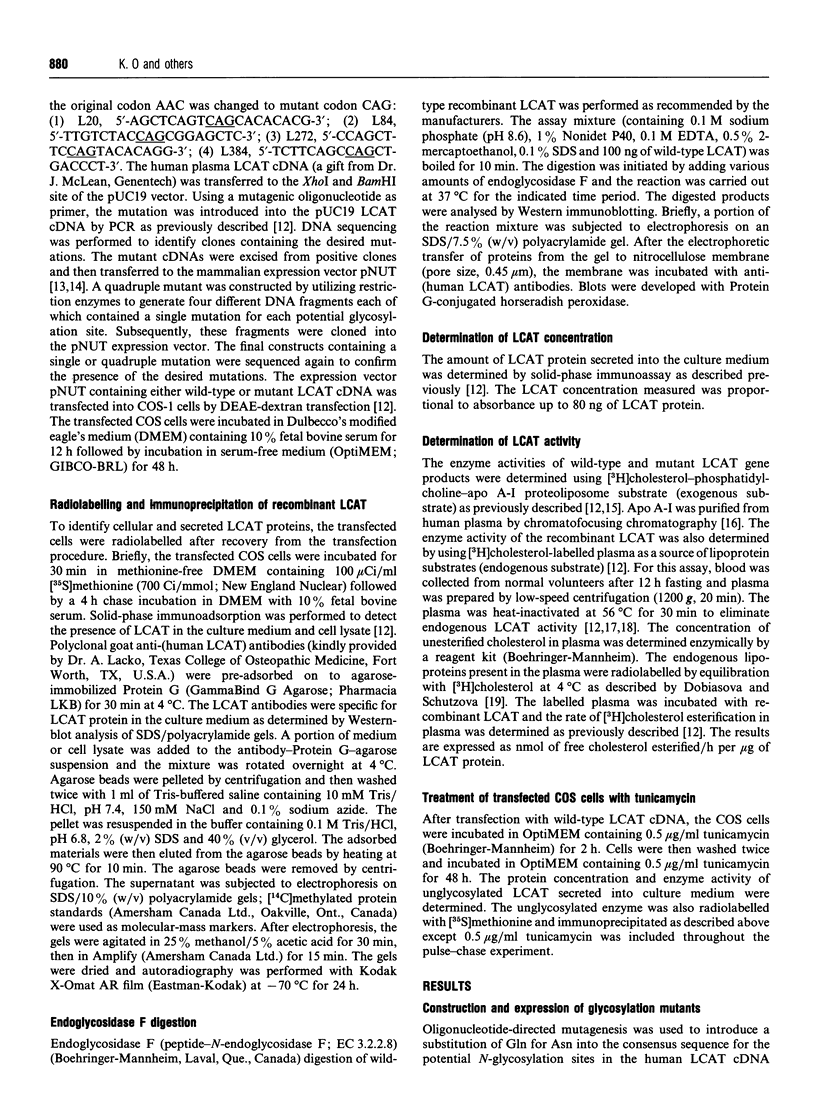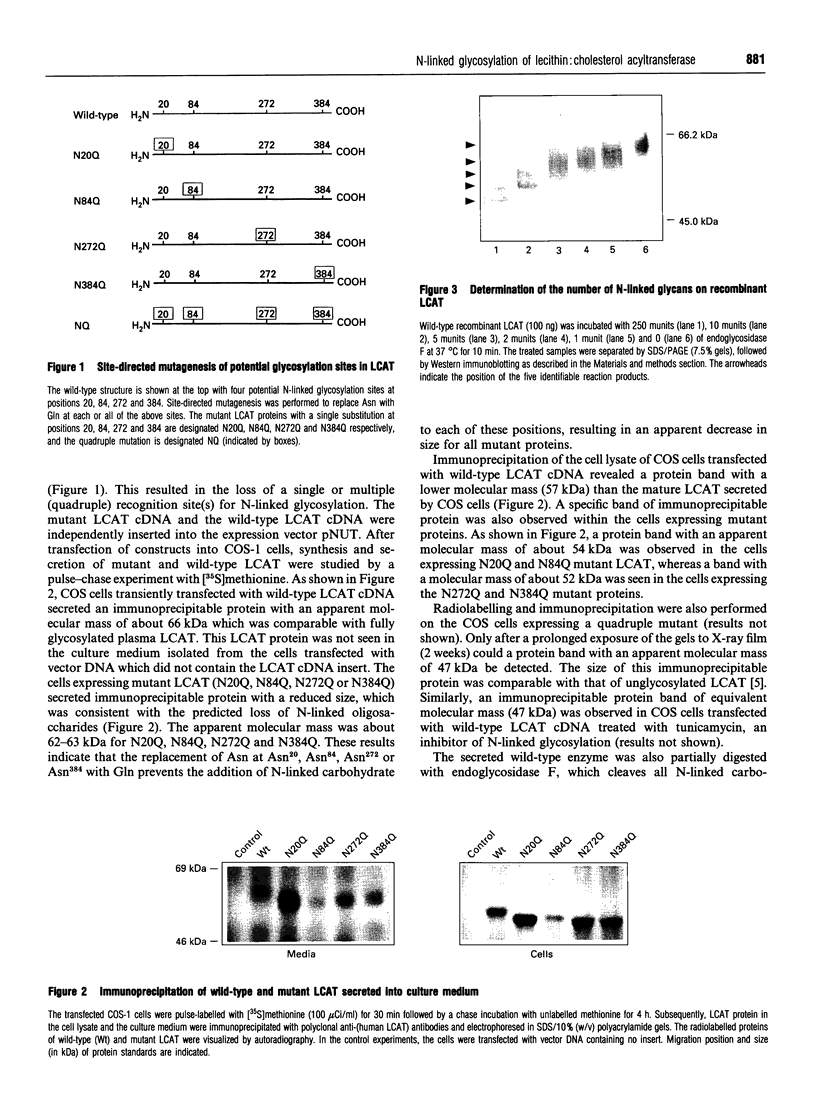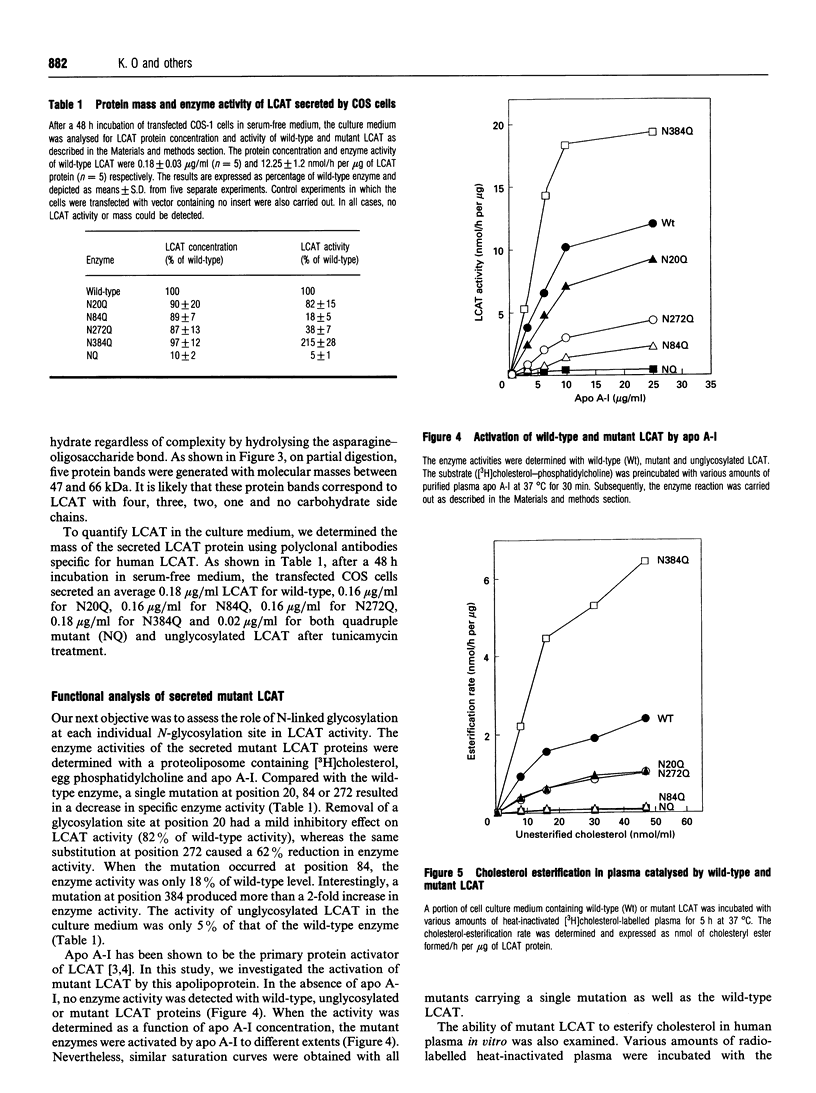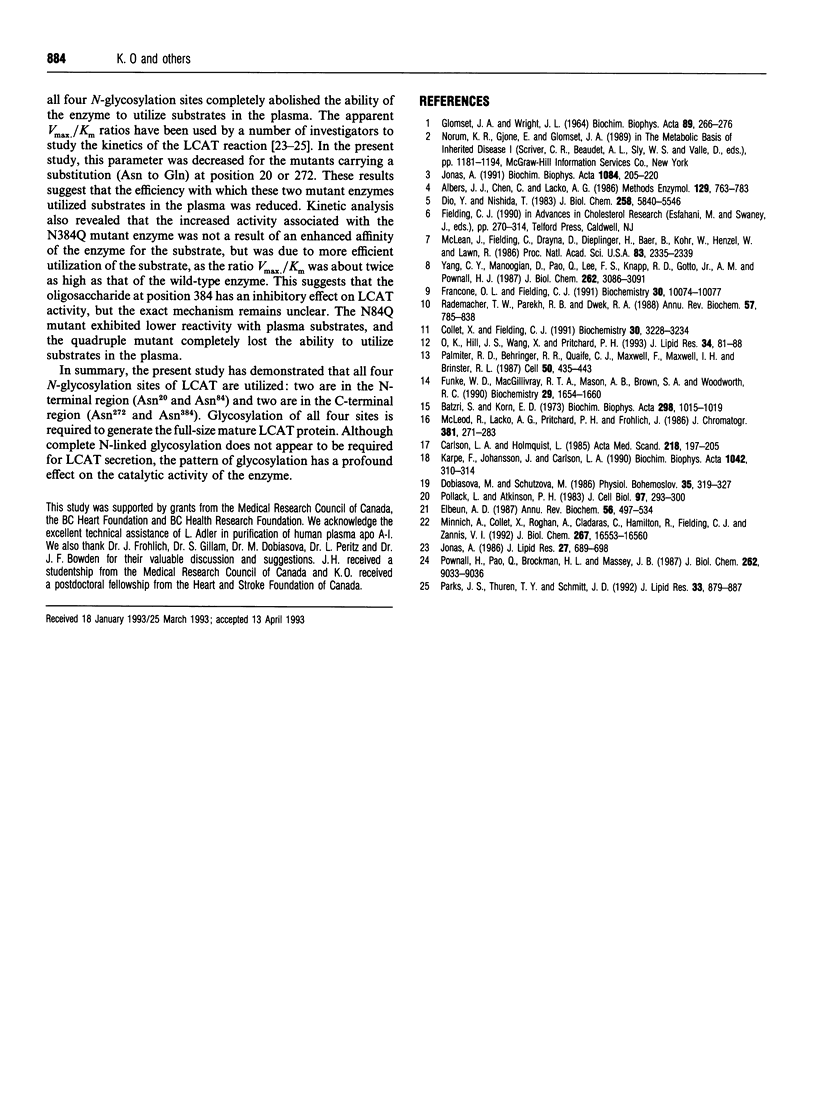Abstract
Lecithin:cholesterol acyltransferase (LCAT; phosphatidylcholine-sterol acyltransferase, EC 2.3.1.43) is a glycoprotein which is responsible for the formation of cholesteryl ester in plasma. The carbohydrate content has been estimated to be approx. 25% of the total LCAT mass, and four potential N-linked glycosylation sites have been predicted at residues 20, 84, 272 and 384 of the LCAT protein sequence. In the present study, we have examined which of these sites are utilized and how the N-glycosylation affects the secretion and function of the enzyme. Site-directed mutagenesis was performed to eliminate the glycosylation consensus sequence at each of the four potential sites, and the mutant proteins were expressed in COS cells. The amount of each mutant LCAT secreted was similar to that of the wild-type enzyme but the molecular mass was decreased by 3-4 kDa. The specific activity of each mutant LCAT was significantly different from the wild-type; however, the magnitude and direction of the change depended on the glycosylation site mutagenized. Loss of carbohydrate at position 20, 84 or 272 resulted in a decrease in the specific activity of the mutant enzymes by 18%, 82%, and 62% respectively. In contrast, the mutant protein without glycosylation at position 384 displayed a 2-fold increase in enzyme activity. In addition, a quadruple mutant was constructed such that all four potential glycosylation sites were eliminated. The amount of the unglycosylated LCAT secreted into the culture medium was less than 10% of the wild-type level and the specific activity of this enzyme was decreased to 5% of that of the wild type. The results demonstrate that all four potential N-glycosylation sites in LCAT are used and the presence of carbohydrate at each site has diverse effects on the enzyme activity.
Full text
PDF





Images in this article
Selected References
These references are in PubMed. This may not be the complete list of references from this article.
- Albers J. J., Chen C. H., Lacko A. G. Isolation, characterization, and assay of lecithin-cholesterol acyltransferase. Methods Enzymol. 1986;129:763–783. doi: 10.1016/0076-6879(86)29103-x. [DOI] [PubMed] [Google Scholar]
- Batzri S., Korn E. D. Single bilayer liposomes prepared without sonication. Biochim Biophys Acta. 1973 Apr 16;298(4):1015–1019. doi: 10.1016/0005-2736(73)90408-2. [DOI] [PubMed] [Google Scholar]
- Carlson L. A., Holmquist L. Evidence for the presence in human plasma of lecithin: cholesterol acyltransferase activity (beta-LCAT) specifically esterifying free cholesterol of combined pre-beta- and beta-lipoproteins. Studies of fish eye disease patients and control subjects. Acta Med Scand. 1985;218(2):197–205. doi: 10.1111/j.0954-6820.1985.tb08847.x. [DOI] [PubMed] [Google Scholar]
- Collet X., Fielding C. J. Effects of inhibitors of N-linked oligosaccharide processing on the secretion, stability, and activity of lecithin:cholesterol acyltransferase. Biochemistry. 1991 Apr 2;30(13):3228–3234. doi: 10.1021/bi00227a010. [DOI] [PubMed] [Google Scholar]
- Dobiásová M., Schützová M. Cold labelled substrate and estimation of cholesterol esterification rate in lecithin cholesterol acyltransferase radioassay. Physiol Bohemoslov. 1986;35(4):319–327. [PubMed] [Google Scholar]
- Doi Y., Nishida T. Microheterogeneity and physical properties of human lecithin-cholesterol acyltransferase. J Biol Chem. 1983 May 10;258(9):5840–5846. [PubMed] [Google Scholar]
- Elbein A. D. Inhibitors of the biosynthesis and processing of N-linked oligosaccharide chains. Annu Rev Biochem. 1987;56:497–534. doi: 10.1146/annurev.bi.56.070187.002433. [DOI] [PubMed] [Google Scholar]
- Francone O. L., Fielding C. J. Structure-function relationships in human lecithin:cholesterol acyltransferase. Site-directed mutagenesis at serine residues 181 and 216. Biochemistry. 1991 Oct 22;30(42):10074–10077. doi: 10.1021/bi00106a002. [DOI] [PubMed] [Google Scholar]
- Funk W. D., MacGillivray R. T., Mason A. B., Brown S. A., Woodworth R. C. Expression of the amino-terminal half-molecule of human serum transferrin in cultured cells and characterization of the recombinant protein. Biochemistry. 1990 Feb 13;29(6):1654–1660. doi: 10.1021/bi00458a043. [DOI] [PubMed] [Google Scholar]
- GLOMSET J. A., WRIGHT J. L. SOME PROPERTIES OF A CHOLESTEROL ESTERIFYING ENZYME IN HUMAN PLASMA. Biochim Biophys Acta. 1964 Aug 26;89:266–276. doi: 10.1016/0926-6569(64)90215-9. [DOI] [PubMed] [Google Scholar]
- Jonas A. Lecithin-cholesterol acyltransferase in the metabolism of high-density lipoproteins. Biochim Biophys Acta. 1991 Jul 30;1084(3):205–220. doi: 10.1016/0005-2760(91)90062-m. [DOI] [PubMed] [Google Scholar]
- Jonas A. Synthetic substrates of lecithin: cholesterol acyltransferase. J Lipid Res. 1986 Jul;27(7):689–698. [PubMed] [Google Scholar]
- Karpe F., Johansson J., Carlson L. A. Studies on the lecithin: cholesterol acyltransferase substrate properties of HDL as determined by its subclass distribution analysed by gradient gel electrophoresis. Biochim Biophys Acta. 1990 Feb 23;1042(3):310–314. doi: 10.1016/0005-2760(90)90158-t. [DOI] [PubMed] [Google Scholar]
- McLean J., Fielding C., Drayna D., Dieplinger H., Baer B., Kohr W., Henzel W., Lawn R. Cloning and expression of human lecithin-cholesterol acyltransferase cDNA. Proc Natl Acad Sci U S A. 1986 Apr;83(8):2335–2339. doi: 10.1073/pnas.83.8.2335. [DOI] [PMC free article] [PubMed] [Google Scholar]
- McLeod R., Lacko A. G., Pritchard P. H., Frohlich J. Purification of biologically active apolipoproteins by chromatofocussing. J Chromatogr. 1986 Sep 5;381(2):271–283. doi: 10.1016/s0378-4347(00)83593-8. [DOI] [PubMed] [Google Scholar]
- Minnich A., Collet X., Roghani A., Cladaras C., Hamilton R. L., Fielding C. J., Zannis V. I. Site-directed mutagenesis and structure-function analysis of the human apolipoprotein A-I. Relation between lecithin-cholesterol acyltransferase activation and lipid binding. J Biol Chem. 1992 Aug 15;267(23):16553–16560. [PubMed] [Google Scholar]
- O K., Hill J. S., Wang X., Pritchard P. H. Recombinant lecithin:cholesterol acyltransferase containing a Thr123-->Ile mutation esterifies cholesterol in low density lipoprotein but not in high density lipoprotein. J Lipid Res. 1993 Jan;34(1):81–88. [PubMed] [Google Scholar]
- Palmiter R. D., Behringer R. R., Quaife C. J., Maxwell F., Maxwell I. H., Brinster R. L. Cell lineage ablation in transgenic mice by cell-specific expression of a toxin gene. Cell. 1987 Jul 31;50(3):435–443. doi: 10.1016/0092-8674(87)90497-1. [DOI] [PubMed] [Google Scholar]
- Parks J. S., Thuren T. Y., Schmitt J. D. Inhibition of lecithin:cholesterol acyltransferase activity by synthetic phosphatidylcholine species containing eicosapentaenoic acid or docosahexaenoic acid in the sn-2 position. J Lipid Res. 1992 Jun;33(6):879–887. [PubMed] [Google Scholar]
- Pollack L., Atkinson P. H. Correlation of glycosylation forms with position in amino acid sequence. J Cell Biol. 1983 Aug;97(2):293–300. doi: 10.1083/jcb.97.2.293. [DOI] [PMC free article] [PubMed] [Google Scholar]
- Pownall H. J., Pao Q., Brockman H. L., Massey J. B. Inhibition of lecithin-cholesterol acyltransferase by diphytanoyl phosphatidylcholine. J Biol Chem. 1987 Jul 5;262(19):9033–9036. [PubMed] [Google Scholar]
- Rademacher T. W., Parekh R. B., Dwek R. A. Glycobiology. Annu Rev Biochem. 1988;57:785–838. doi: 10.1146/annurev.bi.57.070188.004033. [DOI] [PubMed] [Google Scholar]
- Yang C. Y., Manoogian D., Pao Q., Lee F. S., Knapp R. D., Gotto A. M., Jr, Pownall H. J. Lecithin:cholesterol acyltransferase. Functional regions and a structural model of the enzyme. J Biol Chem. 1987 Mar 5;262(7):3086–3091. [PubMed] [Google Scholar]




